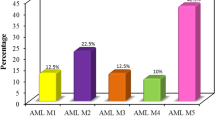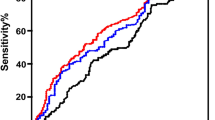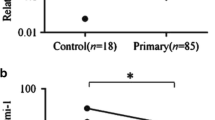Abstract
In acute lymphoblastic leukemia (ALL), limited data are available on mTOR gene expression in clinical samples and its role in predicting response to induction chemotherapy. mRNA expression of mTOR gene was determined quantitatively by real-time PCR in 50 ALL patients (30 B-ALL and 20 T-ALL) and correlated with clinical outcome after induction chemotherapy. Expression level of mTOR was upregulated in more than 50% of cases of ALL. In T-ALL, high expression of mTOR was commonly seen, more in adults than children (82 vs. 55% cases), while in B-ALL it was same (~ 63% cases) in both adults and children. Mean fold change of mTOR expression was significantly higher in non-responders compared to responders of both adult B-ALL (7.4 vs. 2.7, p = 0.05) and T-ALL (13.9 vs. 2.4, p = 0.001). Similar results were seen in pediatric non-responders when compared to responders of both B-ALL (14.5 vs. 2.5, p = 0.006) and T-ALL (24.2 vs. 1.7, p = 0.002). Interestingly, we have observed that mTOR expression was two times higher in non-responders of children compared to adults in both B-ALL (14.5 vs. 7.4, p = 0.05) and T-ALL (24.2 vs. 13.9, p = 0.01). Multivariate analysis with other known prognostic factors revealed that mTOR expression independently predicts clinical response to induction chemotherapy in ALL. This study demonstrates that high mTOR expression is associated with poor clinical outcome in ALL and can serve as a potential target for novel therapeutic strategies.

Similar content being viewed by others
References
Center M, Siegel R, Jemal A. Global cancer facts and figures. Atlanta: American Cancer Society; 2011. p. 1–52.
Farhi DC, Rosenthal NS. Acute lymphoblastic leukemia. Clin Lab Med. 2000;20(1):17–28.
Bassan R, Hoelzer D. Modern therapy of acute lymphoblastic leukemia. J Clin Oncol. 2011;29(5):532–43. doi:10.1200/JCO.2010.30.1382.
Pui CH, Evans WE. Treatment of acute lymphoblastic leukemia. N Engl J Med. 2006;354(2):166–78. doi:10.1056/NEJMra052603.
Mukhopadhyay A, Gangopadhyay S, Dasgupta S, Paul S, Mukhopadhyay S, Ray UK. Surveillance and expected outcome of acute lymphoblastic leukemia in children and adolescents: an experience from Eastern India. Indian J Med Paediatr Oncol. 2013;34(4):280. doi:10.4103/0971-5851.125245.
Pópulo H, Lopes JM, Soares P. The mTOR signalling pathway in human cancer. Int J Mol Sci. 2012;13(2):1886–918. doi:10.3390/ijms13021886.
Hay N, Sonenberg N. Upstream and downstream of mTOR. Genes Dev. 2004;18(16):1926–45. doi:10.1101/gad.1212704.
Gazi M, Moharram SA, Marhäll A, Kazi JU. The dual specificity PI3K/mTOR inhibitor PKI-587 displays efficacy against T-cell acute lymphoblastic leukemia (T-ALL). Cancer Lett. 2017;28(392):9–16. doi:10.1016/j.canlet.2017.01.035.
Granato M, Rizzello C, Romeo MA, et al. Concomitant reduction of c-Myc expression and PI3K/AKT/mTOR signaling by quercetin induces a strong cytotoxic effect against Burkitt’s lymphoma. Int J Biochem Cell Biol. 2016;31(79):393–400. doi:10.1016/j.biocel.2016.09.006.
Janes MR, Vu C, Mallya S, et al. Efficacy of the investigational mTOR kinase inhibitor MLN0128/INK128 in models of B-cell acute lymphoblastic leukemia. Leukemia. 2013;27(3):586–94. doi:10.1038/leu.2012.276.
Saunders P, Cisterne A, Weiss J, Bradstock KF, Bendall LJ. The mammalian target of rapamycin inhibitor RAD001 (everolimus) synergizes with chemotherapeutic agents, ionizing radiation and proteasome inhibitors in pre-B acute lymphocytic leukemia. Haematologica. 2011;96(1):69–77. doi:10.3324/haematol.2010.026997.
Shi PJ, Xu LH, Lin KY, Weng WJ, Fang JP. Synergism between the mTOR inhibitor rapamycin and FAK down-regulation in the treatment of acute lymphoblastic leukemia. J Hematol Oncol. 2016;9(1):12. doi:10.1186/s13045-016-0241-x.
Nemes K, Sebestyén A, Márk Á, et al. Mammalian target of rapamycin (mTOR) activity dependent phospho-protein expression in childhood acute lymphoblastic leukemia (ALL). PLoS ONE. 2013;8(4):e59335. doi:10.1371/journal.pone.0059335.
Ulińska E, Mycko K, Sałacińska-Łoś E, et al. Impact of mTOR expression on clinical outcome in paediatric patients with B-cell acute lymphoblastic leukaemia–preliminary report. Contemp Oncol. 2016;20(4):291. doi:10.5114/wo.2016.61848.
Bhushan B, Chauhan PS, Saluja S, et al. Aberrant phenotypes in childhood and adult acute leukemia and its association with adverse prognostic factors and clinical outcome. Clin Exp Med. 2010;10(1):33–40. doi:10.1007/s10238-009-0067-8.
Livak KJ, Schmittgen TD. Analysis of relative gene expression data using real-time quantitative PCR and the 2—ΔΔCT method. Methods. 2001;25(4):402–8. doi:10.1006/meth.2001.1262.
Cross NC, Melo JV, Feng L, Goldman JM. An optimized multiplex polymerase chain reaction (PCR) for detection of BCR-ABL fusion mRNAs in haematological disorders. Leukemia. 1994;8(1):186–9.
Pui CH, Cheng C, Leung W, et al. Extended follow-up of long-term survivors of childhood acute lymphoblastic leukemia. N Engl J Med. 2003;349(7):640–9. doi:10.1056/NEJMoa035091.
Nachman JB, Heerema NA, Sather H, et al. Outcome of treatment in children with hypodiploid acute lymphoblastic leukemia. Blood. 2007;110(4):1112–5. doi:10.1182/blood-2006-07-038299.
Kamat DM, Gopal R, Advani SH, et al. Pattern of subtypes of acute lymphoblastic leukemia in India. Leuk Res. 1985;9(7):927–34. doi:10.1016/0145-2126(85)90315-7.
Bhargava M, Kumar R, Karak A, Kochupillai V, Arya LS, Mohanakumar T. Immunological subtypes of acute lymphoblastic leukemia in North India. Leuk Res. 1988;12(8):673–8. doi:10.1016/0145-2126(88)90102-6.
Medyouf H, Gusscott S, Wang H, et al. High-level IGF1R expression is required for leukemia-initiating cell activity in T-ALL and is supported by Notch signaling. J Exp Med. 2011;208(9):1809–22. doi:10.1084/jem.20110121.
Tasian SK, Doral MY, Borowitz MJ, et al. Aberrant STAT5 and PI3 K/mTOR pathway signaling occurs in human CRLF2-rearranged B-precursor acute lymphoblastic leukemia. Blood. 2012;120(4):833–42. doi:10.1182/blood-2011-12-389932.
Jiang Z, Wu D, Lin S, Li P. CD34 and CD38 are prognostic biomarkers for acute B lymphoblastic leukemia. Biomark Res. 2016;4(1):23. doi:10.1186/s40364-016-0080-5.
Cascavilla N, Musto P, D’Arena GI, Ladogana S, Matera R, Carotenuto M. Adult and childhood acute lymphoblastic leukemia: clinico-biological differences based on CD34 antigen expression. Haematologica. 1997;82(1):31–7.
Funding
This study was supported by a grant from Department of Science and Technology (DST), Government of India.
Author information
Authors and Affiliations
Contributions
AK designed the study, performed the experiments, drafted the paper and analyzed the data. BB analyzed the data. PSC helped in acquisition and interpretation of data. DKG contributed to diagnosis and treatment of patients. SS supervised the study and contributed to essential reagents and tools. FS designed the study, revised the paper and approved the final and submitted versions of the manuscript.
Corresponding author
Ethics declarations
Conflict of interest
The authors declare that they have no conflict of interest.
Ethical approval
All procedures performed in studies involving human participants were in accordance with the ethical standards of the institutional research committee and with the 1964 Helsinki Declaration and its later amendments or comparable ethical standards.
Informed consent
Informed consent was obtained from all individual participants included in the study.
Rights and permissions
About this article
Cite this article
Khanna, A., Bhushan, B., Chauhan, P.S. et al. High mTOR expression independently prognosticates poor clinical outcome to induction chemotherapy in acute lymphoblastic leukemia. Clin Exp Med 18, 221–227 (2018). https://doi.org/10.1007/s10238-017-0478-x
Received:
Accepted:
Published:
Issue Date:
DOI: https://doi.org/10.1007/s10238-017-0478-x




